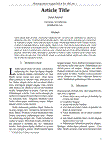| Sumario: | Formulated aquaculture feeds are among the most expensive animal feeds on the market.These feeds are often high in lipids, the bulk of which is generally provided by fish oil.Because of its high cost and potential long-term supply problems, it is now widelyacknowledged that fish oil should be used more sparingly in aquafeeds. Rendered animalfats are economical lipid sources that have been used in fish feeds for decades but their usehas been greatly limited for various reasons, such as poor digestibility and nutritive value,and more recently, fear of disease transmission. Recent studies have indicated that renderedanimal fats can be valuable ingredients in fish feeds. Incorporation levels equal to 30-40%of total lipid of the diet do not impose any negative effects on growth performance, feedefficiency, and product quality of most fish species studied. However, the diet must containsufficient levels of unsaturated fatty acids (mono and polyunsaturated) to allow for properdigestibility of saturated fatty acids, and, obviously, meet essential fatty acid requirementsof the fish. The use of rendered animal fats at the expenses of fish oil in aquafeeds couldimmediately result in significant savings for feed manufacturers.
|
|---|
